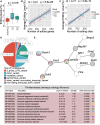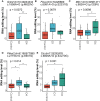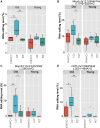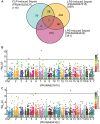Hippocampal adenosine-to-inosine RNA editing in sepsis: dynamic changes and influencing factors
- PMID: 39135964
- PMCID: PMC11317967
- DOI: 10.1093/braincomms/fcae260
Hippocampal adenosine-to-inosine RNA editing in sepsis: dynamic changes and influencing factors
Abstract
Sepsis-associated encephalopathy is a diffuse brain dysfunction secondary to infection. It has been established that factors such as age and sex can significantly contribute to the development of sepsis-associated encephalopathy. Our recent study implicated a possible link between adenosine-to-inosine RNA editing and sepsis-associated encephalopathy, yet the dynamics of adenosine-to-inosine RNA editing during sepsis-associated encephalopathy and how it could be influenced by factors such as age, sex and antidepressants remain uninvestigated. Our current study analysed and validated transcriptome-wide changes in adenosine-to-inosine RNA editing in the hippocampus of different septic mouse models. Seventy-four sites in 64 genes showed significant differential RNA editing over time in septic mice induced by caecal ligation and perforation. The differential RNA editing might contribute to the RNA expression regulation of the edited genes, with 42.2% differentially expressed. These differentially edited genes, especially those with missense editing, such as glutamate receptor, ionotropic, kainate 2 (Grik2, p.M620V), filamin A (Flna, p.S2331G) and capicua transcriptional repressor (Cic, p.E2270G), were mainly involved in abnormal social behaviour and neurodevelopmental and psychiatric disorders. Significant effects of age and sex were also observed on sepsis-associated RNA editing. Further comparison highlighted 40 common differential RNA editing sites that caecal ligation and perforation-induced and lipopolysaccharide-induced septic mouse models shared. Interestingly, these findings demonstrate temporal dynamics of adenosine-to-inosine RNA editing in the mouse hippocampus during sepsis, add to the understanding of age and sex differences in the disease and underscore the role of the epigenetic process in sepsis-associated encephalopathy.
Keywords: RNA editing; age; hippocampus; sepsis-associated encephalopathy; sex.
© The Author(s) 2024. Published by Oxford University Press on behalf of the Guarantors of Brain.
Conflict of interest statement
The authors report no competing interests.
Figures








Similar articles
-
Brain Epitranscriptomic Analysis Revealed Altered A-to-I RNA Editing in Septic Patients.Front Genet. 2022 Apr 26;13:887001. doi: 10.3389/fgene.2022.887001. eCollection 2022. Front Genet. 2022. PMID: 35559016 Free PMC article.
-
Dynamic A-to-I RNA editing during acute neuroinflammation in sepsis-associated encephalopathy.Front Neurosci. 2024 Aug 2;18:1435185. doi: 10.3389/fnins.2024.1435185. eCollection 2024. Front Neurosci. 2024. PMID: 39156629 Free PMC article.
-
Transcriptome-Wide Identification of G-to-A RNA Editing in Chronic Social Defeat Stress Mouse Models.Front Genet. 2021 May 19;12:680548. doi: 10.3389/fgene.2021.680548. eCollection 2021. Front Genet. 2021. PMID: 34093668 Free PMC article.
-
Defining the functions of adenosine-to-inosine RNA editing through hematology.Curr Opin Hematol. 2019 Jul;26(4):241-248. doi: 10.1097/MOH.0000000000000514. Curr Opin Hematol. 2019. PMID: 31033705 Review.
-
Regulatory factors governing adenosine-to-inosine (A-to-I) RNA editing.Biosci Rep. 2015 Mar 31;35(2):e00182. doi: 10.1042/BSR20140190. Biosci Rep. 2015. PMID: 25662729 Free PMC article. Review.
References
-
- Gofton TE, Young GB. Sepsis-associated encephalopathy. Nat Rev Neurol. 2012;8(10):557–566. - PubMed
-
- Semmler A, Okulla T, Sastre M, Dumitrescu-Ozimek L, Heneka MT. Systemic inflammation induces apoptosis with variable vulnerability of different brain regions. J Chem Neuroanat. 2005;30(2–3):144–157. - PubMed
LinkOut - more resources
Full Text Sources
Miscellaneous
